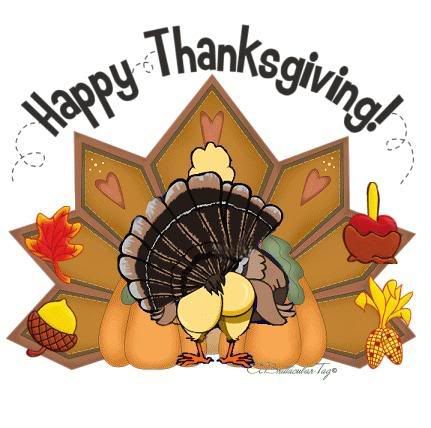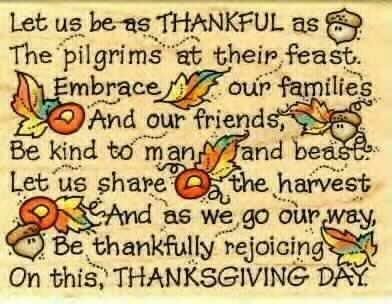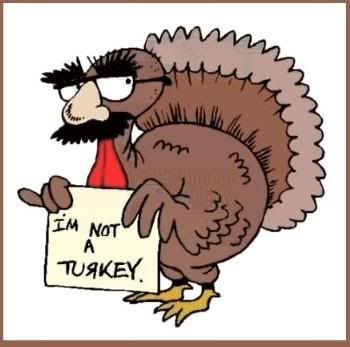The usual tidbits, quotes, pic and link of the day.
Followed by a bevy of Thanksgiving cartoons bound to bring a smile to a full stomach.
Pic of the Day

Quote of the DayThe secret of a good sermon is to have a good beginning and a good ending; and to have the two as close together as possible. |
| Web Site Worth the Visit Bob Dylan’s Words and Beautiful Art Sound on. CLICK HERE |
| TIDBITS CHILDREN'S SCIENCE EXAM Q: Name the four seasons. A: Salt, pepper, mustard and vinegar. Q: Explain one of the processes by which water can be made safe to drink. A: Flirtation makes water safe to drink because it removes large pollutants like grit, sand, dead sheep and canoeists. Q: How is dew formed? A: The sun shines down on the leaves and makes them perspire. Q: How can you delay milk turning sour? (brilliant, love this!) A: Keep it in the cow. Q: What causes the tides in the oceans? A: The tides are a fight between the Earth and the Moon. All water tends to flow towards the moon, because there is no water on the moon, and nature hates a vacuum. I forget where the sun joins in this fight. Q: What are steroids? A: Things for keeping carpets still on the stairs. Q: What happens to your body as you age? A: When you get old, so do your bowels and you get intercontinental. Q: What happens to a boy when he reaches puberty? A: He says good-bye to his boyhood and looks forward to his adultery. Q: Name a major disease associated with cigarettes. A: Premature death. Q: How are the main parts of the body categorized? (e.G., abdomen.) A: The body is consisted into three parts - the brainium, the borax and the abdominal cavity. The brainium contains the brain; the borax contains the heart and lungs, and the abdominal cavity contains the five bowels A, E, I, O, and U. Q: What is the fibula? A: A small lie Q: What does "varicose" mean? (I do love this one...) A: Nearby. Q: Give the meaning of the term "Caesarean Section." A: The Caesarean Section is a district in Rome . Q: What does the word "benign" mean?' A: Benign is what you will be after you be eight. |

Turkey Facts
Ben Franklin, in a letter to his daughter, proposed the turkey as the official United States bird.
In 2005, the average American ate 16.7 pounds of turkey.
In 2005, Turkey was the # 4 protein choice for American consumers behind chicken, beef and pork
The heaviest turkey ever raised was 86 pounds, about the size of a large dog.
A 15 pound turkey usually has about 70 percent white meat and 30 percent dark meat.
The wild turkey is native to Northern Mexico and the Eastern United States.
The male turkey is called a tom.
The female turkey is called a hen.
The turkey was domesticated in Mexico and brought to Europe in the 16th century.
Wild turkeys can fly for short distances up to 55 miles per hour.
Wild turkeys can run 20 miles per hour.
Tom turkeys have beards. This is black, hairlike feathers on their breast. Hens sometimes have beards, too.
Turkeys’ heads change colors when they become excited.
Canadians consumed 138.6 million kg (Mkg) of turkey in the year 2005.
Six hundred seventy-five million pounds of turkey are eaten each Thanksgiving in the United States.
Turkeys can see movement almost a hundred yards away.
Turkeys lived almost ten million years ago.
Turkey feathers were used by Native Americans to stabilize arrows.
Baby turkeys are called poults and are tan and brown.
Most of the turkeys raised for commercial production are White Hollands.
Turkey eggs are tan with brown specks and are larger than chicken eggs.
It takes 75-80 pounds of feed to raise a 30 pound tom turkey.
United States turkey growers raised 256, 270,000 turkeys in 2005
The turkeys produced in 2005 together weighed 7.2 billion pounds and were valued at $3.2 billion.
United States turkey growers will produce an estimated 266,500,000 turkeys in 2006.
Forty-five million turkeys are eaten each Thanksgiving.
Twenty-two million turkeys are eaten each Christmas.
Nineteen million turkeys are eaten each Easter.
Male turkeys gobble. Hens do not. They make a clicking noise.
Gobbling turkeys can be heard a mile away on a quiet day.
Minnesota, North Carolina, Arkansas, Virginia, Missouri and California are the leading producers of turkey in 2005. These states produced 166 million of the 256 million turkeys raised in 2005.
Illinois produced 2.9 million turkeys in 2005 and ranked 15th in turkey production in the United States.
A 16 week old turkey is called a fryer. A five to seven month old turkey is called a young roaster and a yearling is a year old. Any turkey 15 months or older is called mature.
The ballroom dance the "turkey trot" was named for the short, jerky steps that turkeys take.
Turkeys don’t really have ears like ours, but they have very good hearing.
Turkeys can see in color.
A large group of turkeys is called a flock.
Turkeys do not see well at night.
2.74 billion pounds of turkey were processed in the United States in 1994.
A domesticated male turkey can reach a weight of 30 pounds within 18 weeks after hatching.
Turkeys are related to pheasants.
Commercially raised turkeys cannot fly.
Turkeys have heart attacks. The United States Air Force was doing test runs and breaking the sound barrier. Nearby turkeys dropped dead with heart attacks.
Wild turkeys spend the night in trees. They especially like oak trees.
Wild turkeys were almost wiped out in the early 1900's. Today there are wild turkeys in every state except Alaska.
Turkeys are believed to have been brought to Britain in 1526 by Yorkshireman William Strickland. He acquired six turkeys from American Indian traders and sold them for tuppence in Bristol.
Henry VIII was the first English King to enjoy turkey and Edward VII made turkey eating fashionable at Christmas.
In England, 200 years ago, turkeys were walked to market in herds. They wore booties to protect their feet. Turkeys were also walked to market in the United States.
For 87% of people in the UK, Christmas wouldn't be Christmas without a traditional roast turkey.
Turkey breeding has caused turkey breasts to grow so large that the turkeys fall over.
June is National Turkey Lover’s Month.
Since 1947, the National Turkey Federation has presented a live turkey and two dressed turkeys to the President. The President does not eat the live turkey. He "pardons" it and allows it to live out its days on a historical farm.
The five most popular ways to serve leftover turkey is as a sandwich, in stew, chili or soup, casseroles and as a burger.
Eating turkey does not cause you to feel sleepy after your Thanksgiving dinner. Carbohydrates in your Thanksgiving dinner are the likely cause of your sleepiness.
50 percent of U.S. consumers eat turkey at least once per week.
According to the 2002 census, there were 8,436 turkey farms in the United States.
Turkey is low in fat and high in protein.
White meat has fewer calories and less fat than dark meat.
For their first meal on the moon, astronauts Neil Armstrong and Edwin Aldrin ate roast turkey in foil packets.
Turkeys will have 3,500 feathers at maturity.
Turkeys have been bred to have white feathers. White feathers have no spots under the skin when plucked.
Most turkey feathers are composted.
Turkey skins are tanned and used to make cowboy boots and belts.
The costume that "Big Bird" wears on Sesame Street is rumored to be made of turkey feathers.
Israelis eat the most turkeys.....28 pounds per person.
The caruncle is a red-pink fleshy growth on the head and upper neck of the turkey.
Turkeys have a long, red, fleshy area called a snood that grows from the forehead over the bill.
The fleshy growth under a turkey’s throat is called a wattle.
Turkey eggs hatch in 28 days.
The Native Americans hunted wild turkey for its sweet, juicy meat as early as 1000 A.D. Turkey feathers were used to stabilize arrows and adorn ceremonial dress, and the spurs on the legs of wild tom turkeys were used as projectiles on arrowheads.
Number of places in the United States named after the holiday’s traditional main course. Turkey, Texas, was the most populous in 2005, with 492 residents; followed by Turkey Creek, La. (357); and Turkey, N.C. (269). There also are nine townships around the country named “Turkey,” three in Kansas
Sources: United States Census Bureau, National Turkey Federation, British Turkey Federation, United States Department of Agriculture, Canadian Turkey Marketing Association

Thanksgiving Jokes
Why should you keep your eye off the turkey dressing?
Because it makes him blush!Why do turkeys always go "gobble, gobble"?
Because they never learned good table manners!How do you keep a turkey in suspense?
I'll tell you at Christmas.Why did the turkey cross the road?
It was the chicken's day off.What key has legs and can't open doors?
Tur-key.What happened when the turkey met the axe?
He lost his head!Teacher: "Why did the Pilgrims sail to America?"
Student: "Maybe they missed their plane."Teacher: "Why do we have a Thanksgiving holiday?"
Student: "So we know when to start Christmas shopping !"Why can't you take a turkey to church ?
Because they use such FOWL language!If the Pilgrims were alive today, what would they be most famous for?
Their AGE!Knock, knock!
Who's there?
Arthur.
Arthur who?
Arthur any leftovers?How can you tell a male turkey from a female turkey?
The male is the one holding the remote control.What do you call the dirt on a Pilgrim's hands?
Pilgrime!What is your favourite thing to make for Thanksgiving dinner?
Reservations!What did the mother turkey say to her disobedient children?
If your father could see you now, he'd turn over in his gravy!Why didn't the turkey eat dessert??
He was stuffed!What's blue and covered with feathers?
A turkey holding its breath!What cat discovered America?
Christofurry Columbus!Why was the monster tickled when he ate the turkey?
Because he forgot to pluck the feathers!Did you hear about the gobbler who bounced around the barnyard?
He was a perky turkey!What's the best way to stuff a turkey?
Take him out for pizza and ice cream!
More Miscellany posts HERE
==================


No comments:
Post a Comment